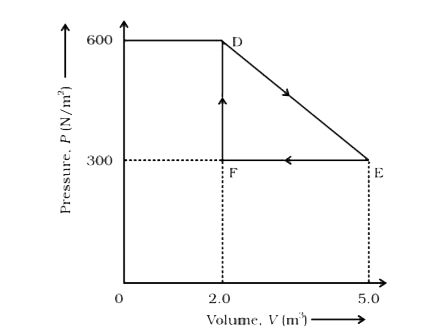Complete Solutions to EXERCISES of chapter THERMODYNAMICS of Class 11 book with complete answers and questions
| Class 11 | PHYSICS |
| Chapter | THERMODYNAMICS |
| NCERT GUJARATI | EXERCISES |
| Number Of Questions | 10 |
| Academic Year | 2023-24 |
A geyser heats water flowing at the rate of 3.0 litres per minute from `27^@` C to `77^@`C. If the geyser operates on a gas burner, what is the rate of consumption of the fuel if its heat of combustion is `4.0xx10^4` J/g ?
View SolutionWhat amount of heat must be supplied to `2.0 xx 10^(-2)` Kg of nitrogen (at room temperature) to raise its temperature by `45^@ C` at constant pressure ? (Molecular mass of `N_2`=28 , `R=8.3 "J mol"^(-1) K^(-1)`)
View SolutionExplain why
(a) Two bodies at different temperatures `T_(1) and T_(2)` if brought in thermal contact do not necessarily settle to the mean temperature `(T_(1) + T_(2))//2`.
(b) The coolant in a chemical or a nuclear plant (i.e., the liquid used to prevent the different parts of a plant from getting too hot) should have high specific heat.
(c) Air pressure in a car tyre increases during driving.
(d) The climate of a harbour town is more temperate than that of a town in a desert at the same latitude.
View SolutionA cylinder with a movable piston contains 3 moles of hydrogen at standard temperature and pressure. The walls of the cylinder are made of a heat insulator, and the piston is insulated by having a pile of sand on it. By what factor does the pressure of the gas increase if the gas is compressed to half its original volume ?
View SolutionIn changing the state of a gas adiabatically from an equilibrium state A to another equilibrium state B, an amount of work equal to 22.3 J is done on the system. If the gas is taken from state A to B via a process in which the net heat absorbed by the system is 9.35 cal,how much is the net work done by the system in the latter case ? (Take 1 cal = 4.19 J)
View SolutionTwo cylinders A and B of equal capacity are connected to each other via a stopcock. A contains a gas at standard temperature and pressure. B is completely evacuated. The entire system is thermally insulated. The stopcock is suddenly opened. Answer the following:
(a) What is the final pressure of the gas in A and B ?
(b) What is the change in internal energy of the gas ?
(c) What is the change in the temperature of the gas ?
(d) Do the intermediate states of the system (before settling to the final equilibrium state) lie on its P-V-T surface ?
View SolutionA steam engine delivers `5.4 xx 10^8` J of work per minute and services `3.6 xx 10^9` J of heat per minute from its boiler. What is the efficiency of the engine? How much heat is wasted per minute ?
View SolutionAn electric heater supplies heat to a system at a rate of 100 W. If system performs work at a rate of 75 joules per second. At what rate is the internal energy increasing ?
View SolutionA thermodynamic system is taken from an original state to an intermediate state by the linear process shown in Fig. (12.13)

Its volume is then reduced to the original value from E to F by an isobaric process. Calculate the total work done by the gas from D to E to F
View SolutionA refrigerator is to maintain eatables kept inside at `9^(@)C`. If room temperature is `36^(@)C`, calculate the coefficient of performance.
View Solution
EXERCISES questions and complete solutions for chapter THERMODYNAMICS of NCERT PHYSICS(GUJRATI) of Class 11